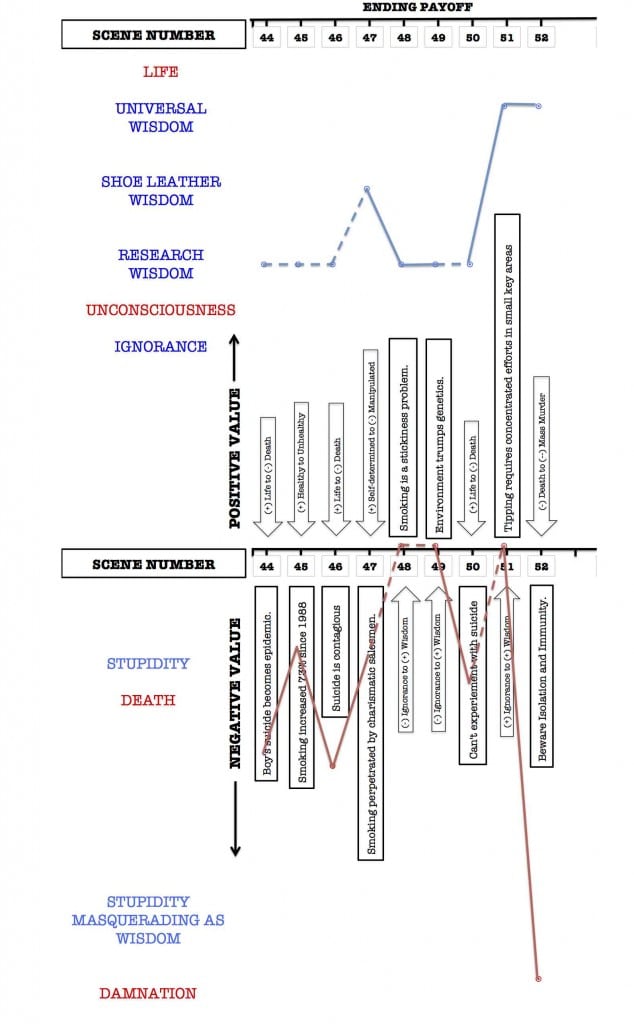Download the Math of Storytelling Infographic
The Ending Payoff of The Tipping Point does not disappoint.
Remember the David Mamet quote about how Stories work in his book Bambi vs. Godzilla?
They start with a simple premise and proceed logically, and inevitably, toward a conclusion both surprising and inevitable.
So what is the surprising and inevitable conclusion of The Tipping Point?
It’s simply that Tipping (from obscurity to ubiquity), while often a wonderful phenomenon that promotes economic stimulus and/or declines in anti-social behavior (Hush Puppies and the dramatic fall of New York Crime respectfully), has a very dark side too.
For more than three quarters of his book, Malcolm Gladwell has been very careful about dipping below the positive in his global story value spectrum.
He’s congenially told his reader about the nifty elements necessary to promote Tipping…the key people necessary to communicate a particular idea (connectors, mavens and salesmen), the necessity of stickiness in the message itself, and the right cultural context required to make a product, behavior or idea “tip.”
But in the ending payoff, Gladwell stresses the negative of Tipping. The fact is that suicide and mass murder are just as contagious as the children’s television show Blue’s Clues is. With charismatic connectors/mavens/salesmen pushing sticky nihilistic messages in moments of cultural uncertainty/desperation, self and mass murderous Tipping can result.
He cites studies of life-threatening behavior (teenage smoking) in his build up to the reality that as our world grows ever more isolating with commercial and cultural messaging ever more frequent and divisive, our ability to counterbalance negative Tipping is diminished. Especially when it concerns future generations.
Today children learn from their peers. NOT from their parents or other adults in multi-generational communities. And rudderless peers intent on “fitting in” with no moral or ethical ballast to keep them from experimenting with irreversible behaviors (suicide/murder) are becoming more and more immune to senior generational influence.
We can’t show our kids how to behave if we’re never with them. And telling them what we believe about right and wrong without their experiencing our direct behavior is meaningless.
If we continue to push our kids away with isolating machinery (cell phones, ipads, etc.) and encourage them to take their behavioral clues from their peers just as our commercially driven culture tells us to do (kids are the most desirous target market and the more they’re isolated, the more they buy), we’re heading for trouble.
Remember that The Tipping Point was published in March 2000. More than fifteen years ago…
This from the Afterword,
The post-Columbine outbreak of school shooting is, in this sense, no different. It is happening because Columbine happened, and because ritualized, dramatic self-destructive behavior among teenagers—whether it involves suicide, smoking, taking a gun to school, or fainting after drinking a harmless can of Coke—has extraordinary contagious power.
My sense is that the way adolescent society has evolved in recent years [the adolescent society Gladwell speaks of in 2000 is now in their 20s and 30s] has increased the potential for this kind of isolation. We have given teens more money, so they can construct their own social and material worlds more easily. We have given them more time to spend among themselves—and less time in the company of adults. We have given them e-mail and beepers and, most of all, cellular phones, [Gladwell wrote The Tipping Point before texting] so that they can fill in all the dead spots in their day—dead spots that might once have been filled with the voices of adults—with the voices of their peers. That is a world ruled by the logic of word of mouth, by the contagious messages that teens pass among themselves. Columbine is now the most prominent epidemic of isolation among teenagers. It will not be the last.
Here’s the Ending Payoff Story Grid infographic for The Tipping Point.
Download the Math of Storytelling Infographic
Share this Article:
🟢 Twitter — 🔵 Facebook — 🔴 Pinterest
Sign up below and we'll immediately send you a coupon code to get any Story Grid title - print, ebook or audiobook - for free.
(Browse all the Story Grid titles)
